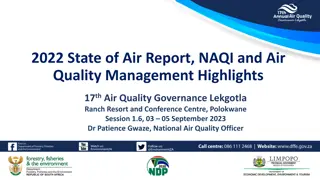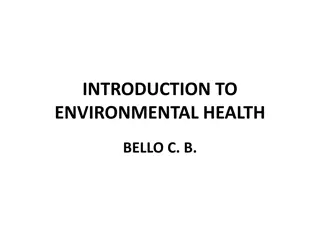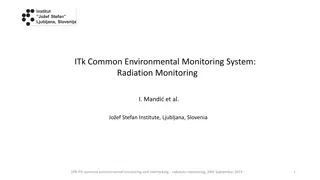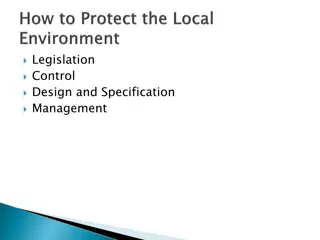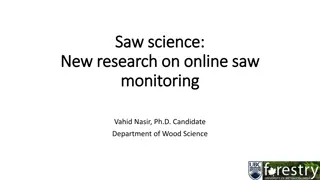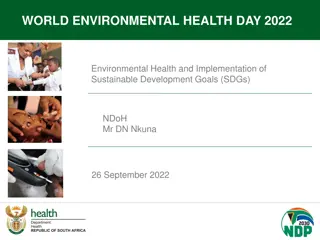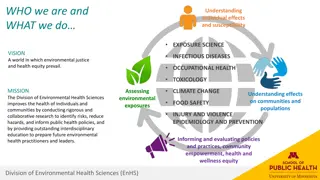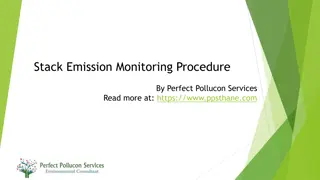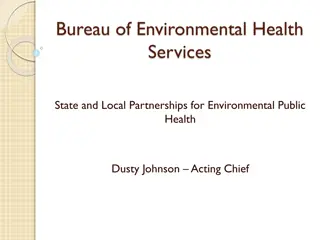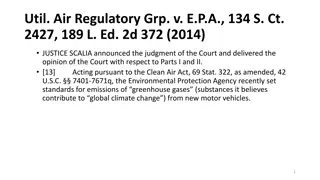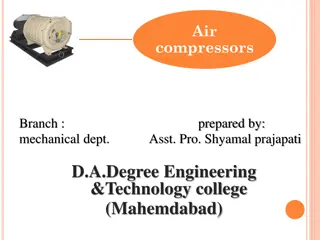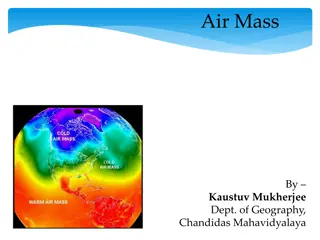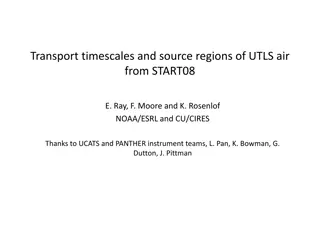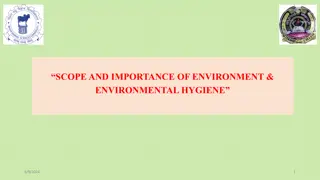Engaging Community in Air Monitoring for Environmental Health
Engaging community members in air monitoring processes allows for active participation in identifying toxic chemical sources, documenting health impacts, and influencing regulatory actions. Examples from Louisiana, Mississippi, Texas, and Colorado highlight the importance of community involvement in addressing environmental concerns through data collection and collaboration with regulatory agencies.
Uploaded on Sep 12, 2024 | 0 Views
Download Presentation

Please find below an Image/Link to download the presentation.
The content on the website is provided AS IS for your information and personal use only. It may not be sold, licensed, or shared on other websites without obtaining consent from the author. Download presentation by click this link. If you encounter any issues during the download, it is possible that the publisher has removed the file from their server.
E N D
Presentation Transcript
Community Air Monitoring in Louisiana, Mississippi, Texas & Colorado By: Wilma Subra Subra Company subracom@aol.com January 16, 2024
When performing community air monitoring, engaging community members in the process and more importantly allowing community members to participate by submitting odors complaints and negative public health impacts, etc. to the process and to the environmental regulatory agencies. This is critical to educating and empowering community members on the situations that are taking place in their communities. 2
In response to community members input, structure air sampling to document potential sources of toxic chemicals being released, specific chemicals being released, quantities, frequencies, causes of the release events, and associated health impacts corresponding to the chemicals being released into the air or into other environmental media. Consider establishing methods of timely air sampling in response to community member complaints. Establish methods of timely providing community members with the results of the air sampling. 3
Work with local and statewide regulatory agencies to provide information in a timely manner to community members being negatively impacted and to the sources of toxic emissions being released into the communities environments. Make community members active participants in the process of air monitoring procedures and in evaluation and forward moving processes of information distribution. 4
Specific Locations of Community Air Monitoring and Results The following locations and exposed, poisoned and resulting health impacts on community members, are examples of methods of engaging community members in the air monitoring process and working to address some of the problems. Port Arthur, Texas Odor and Symptom Logs, correlated health impacts with chemicals being released by industrial facilities in the areas around the residential areas and correlated with incident releases from industrial facilities in the community. 5
Specific Locations of Community Air Monitoring and Results Pascagoula, Mississippi Health Survey performed and correlated with toxic chemicals in the air and being released from industrial facilities. Mossville, Calcasieu Parish, Louisiana Correlation of Dioxins and Furans congeners in industrial emissions to community members blood concentrations of Dioxin and Furans, attic dust and household dust samples containing Dioxins and Furans in community members homes. 6
Specific Locations of Community Air Monitoring and Results Clean Harbors, Colfax, Louisiana Community complaints associated with Clean Harbors Open Burn/Open Detonation of reactive, energetic and explosive waste. The community complaints are associated with burn plumes moving offsite, contaminating off site air, soil and water, being deposited on community members skin, loud explosive and detonation events that shake homes and disrupt the wellbeing of community members, and negative impacts of the waste streams that are transported to the site and ignited. In addition, the operations of the facility do not comply with permit requirement conditions. The waste streams ignited, burn logs and quantities of waste ignited are only available to community members and the regulatory agencies on days community members submit complaints. 7
Denka Performance Elastomer: Reserve, Louisiana Denka manufactures Chloroprene and Neoprene in Reserve, St. John the Baptist Parish, Louisiana. The Chloroprene Unit, Neoprene Unit, the HCL Recovery Unit and Utilities have been in operation since November 2015. Chloroprene is released into the air from the Denka facility. 8
Denka Performance Elastomer: Reserve, Louisiana The National Air Toxics Assessment (NATA), in December 2015, released a screening-level assessment and classified Chloroprene as a likely human carcinogen. The long-term cancer-based caparison level for a 100 in 1 million cancer risk comparison level is 0.2 ug/m3 for Chloroprene EPA established 24-hour summa canister, ambient air monitoring locations at six locations around the Denka facility. 9
Denka Performance Elastomer: Reserve, Louisiana EPA also required Denka to establish five, then six, ambient air monitoring locations for Chloroprene around the Denka facility. The ambient air monitoring data demonstrated that the Denka and EPA air concentrations of Chloroprene exceeded the 0.2 ug/m3 concentration standard on an ongoing basis in residential areas and on the Fifth Ward Elementary School grounds. Testing of human urine samples demonstrated metabolites of Chloroprene in humans in the areas around the Denka facility. 10
Ethylene Oxide On August 22, 2018, the EPA released the 2014, National Air Toxics Assessment (NATA) for Ethylene Oxide. Ethylene Oxide significantly contributed to potential elevated cancer risks in some census tracts across the United States. Louisiana has 13 industrial facilities in five parishes releasing Ethylene Oxide into the air. The US has 118 industrial facilities releasing Ethylene Oxide into the air. 11
Ethylene Oxide Together Texas and Louisiana have the top seven industrial facilities releasing the largest quantities of Ethylene Oxide into the air in the United States. Ethylene Oxide is a hazardous air pollutant that is a flammable colorless gas used to make other chemicals. It is manufactured from Ethylene and is used primarily as a chemical intermediate in the manufacturing of Ethylene Glycol. Ethylene Oxide is also used as a sterilizing agent for medical supplies and equipment. 12
Cultavando The Suncor Refinery in Central City near Denver, Colorado is located adjacent to a Latinix community. The Cultavando organization representing the Latinix community, received completive funding from the environmental agency. The funds were from a fine for violations of regulations by Suncor. Cultivando hired consultants and established air monitoring in the area of the refinery and surrounding areas. The results of the monitoring were available in real time on the internet. 13
Cultavando Action Levels were established for the monitoring parameters. When an action level was exceeded, each home, business and school in the area was notified, the action level exceeded was presented and the action activities the community members should and should not do were emailed to them immediately. I developed the health impacts associated with the monitoring parameters and provided the information to the community members to post in their homes. When they received an alert, the community members could immediately determine the health impacts associated with the action level chemical. 14
Detailed Community Monitoring Information: Port Arthur, Texas In late 1999, EPA contacted me and indicated the EJ community in Port Arthur had an environmental justice grant and needed assistance performing the air monitoring portion of the grant. EPA asked for my assistance. I developed an odor and symptom log for the community members to fill out. They completed the log form every time they experienced an odor event. They included their location where they smelled the odor. 15
Detailed Community Monitoring Information: Port Arthur, Texas DURING 2000 # OF ODOR & SYMPTOM LOGS COMPLETED 77 298 19 24 January February March April 16
Symptoms Headache Sore Throat Burning or Watering Eyes Dizziness or Lightheadedness Difficulty Breathing Coughing Nausea Diarrhea Skin Rashes Nose Bleeds . 17
The Environmental Justice Community of West Port Arthur, Texas is surrounded by petroleum refineries, petrochemical plants and marine loading facilities. The industrial facilities notify the Texas Natural Resources Conservation Commission (TNRCC) or Texas Commission of Environmental Quality when they have a major upset, emission or maintenance activities. These events are known as incidents. 18
Clark Refining and Marketing/Valero Port Arthur Refinery January 2000 15 incidents with three odor events. February 2000 1 incident odor log. Huntsman Petro Chemical Corp. 4 notifications to TNRCC. January 2, Notification of which 1 also had an Odor and Symptom Log. Motiva Refinery 13 notifications to TNRCC. January 2000 12 notifications with three odor and symptom logs. February 2000 20 notifications with 19 odor and symptom logs. 19
Chevron 0 notifications to TNRCC 1 odor and symptom log submitted. March 2000: 19 Odor and Symptom Logs. April 2000: 24 Odor and Symptom Logs. No dates: 22 Odor and Symptom Logs. Total Odor and Symptom Logs January March 2000 570 Odor and Symptom Logs. 20
Symptoms Reported on Odor & Symptom Logs in Port Arthur Symptoms January 2000 February 2000 March 2000 Headaches Sore Throat 8 8 23 21 6 5 Burning or Watery Eyes 8 21 5 Dizziness or Lightheadedness 9 18 6 Difficulty Breathing 8 22 7 Coughs Nausea 9 8 20 21 6 5 Diarrhea 8 17 3 Skin Rash 3 13 2 Nose Bleeds 4 10 2 21
Odor Reports 22 Strong Smell & Bad Taste Horrible, Terrible Smell Chlorine Fog Burning Very Putrid Smell Strong Oil Spill Like Odor Old Oil in Ditch Garlic Odor and Doke Dust Paint Odor, Very Strong Acid Smell Rotten Eggs Sulphur Burnt Rubber Gas Benzene Chemicals Caustic Acid Black Smoke Out of Stack Refinery Siren Went Off Very Smokey Lots of Smoke
Upset/Maintenance Conditions Reported to TNRCC of Major Companies Company TNRCC Notifications Dates In January 2000 Dates in February 2000 Clark Refining 6 15 1 Huntsman Petrochemical Corp. Motiva Enterprises 4 2 5 13 15 20 Chevron 0 0 0 23
Upset/Maintenance Conditions in January 2000 from Clark, Motiva and Huntsman Hydrogen Sulfide, Sulfur Dioxide, Nitrogen Oxide, Carbon Monoxide, Particulates, Hydrocarbons, Benzene, Butadiene Upset/Maintenance Conditions in February 2000 from Clark, Motiva, Huntsman, Fina and Chemical Waste Hydrogen Sulfide, Sulfur Dioxide, Nitrogen Oxide, Carbon Monoxide, Particulates, Hydrocarbons, Benzene, Fire Training Emissions 24
Community of West Port Arthur, Texas The community of West Port Arthur is surrounded by petroleum refineries, petrochemical plants and marine loading facilities. Two thirds of the days in January and February 2000, accidental releases, upset conditions and maintenance conditions released excess emissions into the air of West Port Arthur. These chemicals were released by Clark Refinery, Motive Refinery and Huntsman Petrochemical. The Motiva Refinery had releases on 32 days with as many as four releases of multiple chemicals on a single day. 25
Community of West Port Arthur, Texas The Clark Refinery had releases on 16 days with multiple chemicals being released each day. The health of the community, as well as their quality of life was negatively impacted by the accidental releases. Canister air samples, collected by the state agency as well as on behalf of community members, have demonstrated that the chemicals released during accidents and upsets have crossed the fence line and impacted the people in the residential areas as well as students in the schools. 26
Community of West Port Arthur, Texas I was serving on the EPA Common Sense Initiative, Petroleum Refinery workgroup., while working in Port Arthur. I provided refinery representatives in the workgroup with the data accumulated on Port Arthur and the negative health impacts experienced by community members. After presenting the information to the community members in Port Arthur, the community members had a better understanding of what was happening to them and their health. 27
Community of West Port Arthur, Texas The industry representatives in Port Arthur told the community: Get Rid of Wilma! Quit filling out and collecting the Odor and Symptom Logs! The industry representatives told the community members We will give you playground equipment for your community if you do the two things listed above. Note: This work was performed by Wilma Subra of Subra Company at the request of EPA. 28
Community of West Port Arthur, Texas Hilton Kelly of Community In Power and Development Association had not yet returned to Port Arthur and assumed the position of community leader. In addition, John Beard, Jr., Port Arthur Community Action Network was also not yet involved as a community leader in the Port Arthur area. 29
Pascagoula, Mississippi Health Survey In 2020, community members in Cherokee Subdivision in Pascagoula, Jacksons County, Mississippi complained that they were all very ill from being exposed to toxic chemicals from industrial facilities in their community. I met with the community and developed a health survey form for the community members living in Cherokee Subdivision and prepared a report on the results of the health survey. 30
Pascagoula, Mississippi Health Survey The subdivision consisted of 150 homes, with 20 empty houses. A total of 80 individuals were surveyed, 54% female, 44% male and 2% unidentified. Ages ranged from 3 to 80 years of age. The community members lived at their current addresses for 6 months to 52 years. 31
Pascagoula, Mississippi Health Survey Of those surveyed, 85% never smoked. Those that smoked, smoked from 0.5 to 1 pack of cigarettes per day and had smoked from 4 years to 31 years. The occupations of those surveyed ranged from engineers, store clerks, health care workers to housewives. Individuals surveyed consisted of 52.5% healthy and 47.5 % ill. 32
Pascagoula, Mississippi Health Survey Of the individuals surveyed 96% experienced odors, two to 30 days per month, averaging 22.6 days per month. Surveyed community members described the odors and reported their health impacts associated with the odors and health impacts not associated with odor incidents. Industrial sources of the odors were identified. 33
Pascagoula, Mississippi Health Survey A total of large industrial facilities in the area associated with the odors consisted of: Chevron Pascagoula Refinery founded in 1963 First Chemical founded in 1967 Ingalls Shipyard founded in 1938 Mississippi Phosphate founded in the late 1950 s. Signal Shipyard founded in 2003 VT Halter Marine founded in 2002 34
Pascagoula, Mississippi Health Survey Chemicals from the industrial facilities were based on Toxic Release Inventories and air permits. Community members identified the chemicals associated with the odors/incidents. The acute and chronic health impacts were developed for each chemical. A total of 70 toxic chemicals (organic, inorganic and heavy metal) were released by the industrial facilities. 35
Pascagoula, Mississippi Health Survey The acute and chronic health impacts associated with the 70 toxic chemical materials matched the health impacts reported by the community members The cumulative impacts to community members inhaling the chemicals released into the air, added to the negative health impacts experienced by the community members. The acute (short term exposure) and chronic (long term exposure) health impacts associated with the 70 chemicals released by the industrial facilities into the air, match the health impacts reported by community members in the survey as a result of exposure to odor events. 36
EPA Region 4 EPA Region 4 reviewed the results of the Pascagoula Health Survey and then requested a survey be performed on the industrial facilities releasing the toxic chemicals in the Pascagoula area. EPA Region 4 in Atlanta granted the state of Mississippi $500,000 to conduct air monitoring in the Pascagoula area. 37
GMAP The Geospatial Measurement of Air Pollution (GMAP), a mobile air monitoring unit stationed in Colorado and a forward-looking infrared (FLIR) camera were used. The GMAP unit surveyed concentrations of Methane, Hydrogen Sulfide, Sulfur Dioxide, Volatile Organic Compounds and Benzene, Toluene, Ethylbenzene, m-Xylene, o-Xylene and p-Xylene. The GMAP van monitored around and inside the industrial facilities at First Chemical/Chemours, Chevron, VT Halter Marine, Ingalls Shipyard, Mississippi public roads surrounding the industrial locations and inside the industrial facilities. 38
GMAP The monitoring data provided critical information on the toxic chemicals being released by the industrial facilities and specific areas in the industrial facilities and onto facility property where the toxic chemicals were being released. The analytical monitoring data was critical to achieving toxic chemicals reductions from specific areas of each industrial facility and redirections of the industrial facilities which assisted in reducing offsite chemical concentrations within the residential areas where community members were being negatively impacted. 39
Transit As the GMAP (Geospatial Measurement of Air Pollution) mobile air monitoring unit headed back to Colorado, I received a call from the EPA Administrator of Region 6 (Dallas). He indicated the GMAP had two days remaining for mobile air monitoring before being due back in Colorado. He requested my suggestions for two facilities on the route back to Colorado to spend two days performing air monitoring. I suggested Mossville in Calcasieu Parish, Louisiana and Clean Harbors in Central Louisiana in Grant Parish. 40
Mossville, Calcasieu Parish, Louisiana Since 1998, ATSDR has conducted an Exposure Investigation of Dioxins in Mossville, Louisiana. Mossville have an average level of dioxins that is 3 times higher than the average level of dioxins in the general U. S. population. Dioxins are the most toxic chemicals known to science. There is no safe level of dioxin compounds. 41
Mossville, Calcasieu Parish, Louisiana Mossville is a historic, African American community founded in the 1790 s. The Mossville residents are surrounded by 14 toxic industrial facilities, several of which routinely release dioxins into the air, water and land. There is a direct link between the dioxin compounds detected in the blood of Mossville residents and the dioxin compounds released into the environment by the Georgia Gulf industrial facility. 42
Mossville, Calcasieu Parish, Louisiana Dioxin is also detected in household indoor dust, attic dust in the homes in Mossville, in the yard soil, fish, fruits, vegetables and nuts. In addition, a host of toxic chemicals being released into the Mossville environment from the industrial facilities have contaminated the Mossville Environment with a large number of toxic volatile and semi-volatile organic compounds, heavy metals, Ethylene Oxide, toxic Vinyl Chloride. When the GMAP monitored around the industrial facilities in Mossville and surrounding areas, leaking tanks were identified, toxic emissions from vents on storage tanks were pointed out, and industrial emissions being released from stacks and vents were identified. 43
Mossville, Calcasieu Parish, Louisiana Ethylene Oxide is released into the air in Louisiana from 13 industrial facilities in five parishes. I received a call from EPA concerning Ethylene Oxide emissions on August 21, 2018. The following day, August 22, 2018 EPA released the 2014 NATA Ethylene Oxide Information because it was of potential long term concern and it was on the federal list of carcinogens since 1985. 44
Mossville, Calcasieu Parish, Louisiana Together Louisiana and Texas have the top seven industrial facilities releasing the largest quantities of Ethylene Oxide into the air in the United States. The United States has 118 industrial facilities releasing Ethylene Oxide into the air. Ethylene Oxide is manufactured from Ethylene and is used primarily as a chemical intermediate in the manufacturing of Ethylene Glycol. 45
Health Impacts of Ethylene Oxide Carcinogen in humans if inhaled. May be a teratogen (malformation of the embryo) in humans since it is a teratogen in animals. May damage developing fetus. May damage testes. Long term exposure harms the brain and nervous system. 46
Health Impacts of Ethylene Oxide 47 Louisiana has five of the 25 highest priority facilities identified by EPA. Company Parish Evonicks Materials Union Carbide BCP Ingredients Taminco Sasol Chemicals St. John the Baptist Parish St. Charles Parish Iberville Parish Iberville Parish Calcasieu Parish
Clean Harbors Colfax, LLC Clean Harbors Colfax, LLC operates an open burn/open detonation (OB/OD) facility which thermally treats reactive, energetic, explosive waste. The facility consists of: 20 square burn pads (6 feet by 6 feet) 10 storage magazines for storage of reactive and explosive waste 1 preparation building Clean Harbors is the only commercial operation of OB/OD explosive, energetic and reactive waste in the US. 48
Clean Harbors Colfax, LLC It treats over 300 energetic/reactive waste streams in solid, sludge and liquid forms. An emergency permit for treatment for hazardous waste was granted in June 1985. The permit allowed open burning of explosives. Ammonium perchlorate was used as the oxygenation agent and 41,400 pounds per year was allowed. 49
Clean Harbors Colfax, LLC Emissions of ammonium perchlorate from the open burn/ Open detonation resulted in the majority of community members having thyroid problems. Perchlorate has contaminated the ground water, surface water, soi, sediment and air. A total of 2.2 million pounds of waste from the Camp Minden site was transferred to Clean Harbors and OB/OD. 50












